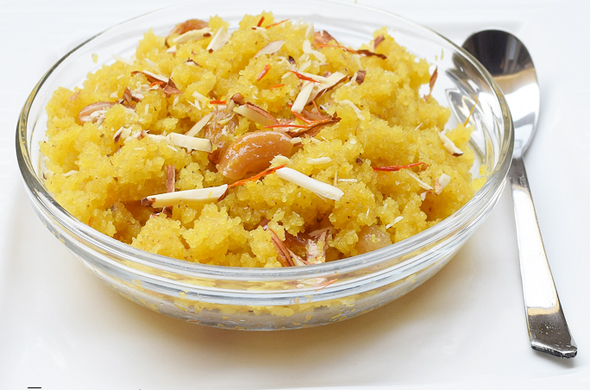Mama’s Punjabi Recipes: Suji da Halva (Semolina Halva)
Saved under Community, Current Stories, Recipe Corner
Tags: Baytown, Clear Lake, Cypress, Desi news, Greater Houston, Houston, Houston Desi news, India, Indian American community, Indian News, Indians in America, Indo-American News, Katy, NRI, pearland, south asia, South India, Sugar Land, Texas, USA
By popular demand from many readers, below is a reprint of Mama’s Suji da Halva recipe. It is a dessert that is also made on auspicious occasions to celebrate an achievement or special moment. It is reprinted with some additional information and directions.
There are many types and of halvas and many ways to prepare them. In the Punjab, the karah or karda is a wheat flour halva that is often served at religious functions and is always served at the langars (communal meals) after services in Sikh Gurudwaras. Although this sweet dish is considered mostly a Northern Indian confection, and is associated with Punjabi cuisine, it is also quite popular in South India.
Suji halva is often made to commemorate special occasions, like a birthday or the start of a new venture or phase of life like a taking exams or starting a new job. Among Hindus, a small offering of the halva is made to the deities in the home temple and then given to the concerned person first as a blessing for good luck and then to the other family members.
Suji (semolina) is the coarse, purified middlings of durum wheat that is also used to make pasta and couscous. It is high in carbohydrates, vitamins B1, B3 and B9 as well as magnesium, phosphorus and zinc. Different varieties are also used to make porridge, the South Indian dishes rava dosas, upma and is sometimes used to coat dishes before they are baked to prevent sticking.
Suji halva is quite simple to make and while it is cooking, the kitchen fills with a pleasant aroma. It is best when eaten warm, right after it is prepared when it is still soft, as it thickens as it cools down. For more authentic taste, most Punjabis eat it with some nuts – usually blanched almonds – and the dish is great for cold wintery days.
Ingredients:
1 cup ghee (or olive oil for a healthier option)
1 cup suji (semolina, medium grain for best results)
1 cup chinni (white sugar) – or choose brown sugar or gur (jaggery)
3 cups pani (water)
½ cup dried fruit (raisins, broken pieces of almonds)
Directions:
1. In a saucepan mix the sugar and 3 cups of water and bring to a boil over high heat. If the suji is a large grain, then use four cups of water. If you prefer a sweeter halva, use 1.5 cups of sugar. Make sure the sugar is dissolved well, take off the heat and set the syrup aside.
2. In a karahi (wok) warm the oil over medium heat and add the suji. Stir till the grain becomes slightly brown.
3. Reduce the heat then and slowly pour the syrup in while continuously stirring.
4. Reduce the heat to a minimum and if the mixture starts to bubble from the edges then turn off the heat.
5. Add the dry fruit and stir in. If you prefer, you can add the dry fruit while the suji is being roasted.
6. For best results, boil whole almonds to peel the skin and then slice the blanched nuts in slivers. Use these in the mixture and sprinkle over the halva for presentation.
MAMA’S TIP OF THE WEEK
MAKE SOME EASY LASSI TO COOL OFF ON A SUMMER DAY!
Lassi (buttermilk) is a popular drink in India, either sweetened or salty, and is available in many flavors, especially in the sweet varieties. On a hot summer day, it has the ability to cool you off quickly and also help with a bloated stomach, constipation and other digestion problems. Usually, in rural India, and where I grew up, lassi was the residual water from the process of making butter and we considered ourselves lucky to be there was it was being made so that we could drink the lassi in a tall, large, conical shaped brass glass.
For those who don’t have that opportunity, what is usually called lassi these days is a yogurt drink made by cutting some yogurt by adding water and then some flavor to it. But before you just dilute the yogurt, be sure to take a large spoonful of it and beat it till it is nicely blended. Then, when you add the water, you won’t get little lumps of yogurt sticking to the glass or floating in the water.

Shakuntla Malhotra is a skilled cook of Punjabi dishes made in the old-fashioned style that she learnt as a young woman in her ancestral home in Lyallpur (since renamed Faisalabad), India before it became part of Pakistan after the Partition in 1947. People have often admired her cooking for its simplicity and taste that comes with each mouthful. Even in her mid-eighties, she continues to cook daily and agreed to share some of her delectable Punjabi recipes

